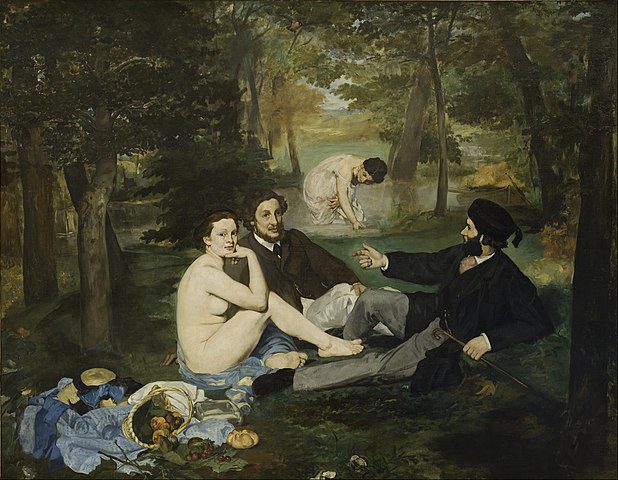
What happens when a muse becomes the artist? The story of Victorine Meurent, Édouard Manet’s most famous model, is one of both fame and obscurity. Known for her striking appearances in controversial masterpieces like Olympia and Luncheon on the Grass, Victorine Meurent was a woman who challenged conventions. But while Manet’s paintings have become some of the most celebrated works in art history, Victorine’s story faded into the background—until recently.
Victorine wasn’t just a passive model. She was also an accomplished painter, fighting for recognition in the male-dominated world of 19th-century art. However, her life and work were long overshadowed by the scandal surrounding the paintings in which she appeared. Today, her rediscovery is helping to reshape the narrative of art history, reminding us that the contributions of women have often been overlooked or erased.
Who Was Victorine Meurent?
Victorine Meurent was born in Paris in 1844 to a working-class family. From an early age, she showed artistic talent, but her opportunities were limited due to her social class and gender. As a teenager, she began working as a model for artists to support herself. This was not unusual for working-class women in Paris at the time, though it came with social stigmas. But Victorine’s distinct features—fair skin, red hair, and a petite figure—quickly caught the attention of leading artists.
Her modeling career began in the early 1860s when she posed for painter Thomas Couture. But it was her work with Édouard Manet, starting around 1862, that would make her famous. Their partnership would produce some of the most iconic and controversial images in art history. At the same time, Victorine was more than just a face for Manet’s canvas. She was studying to be an artist herself, honing her skills at the prestigious Académie Julian, an art school that accepted women, a rare opportunity for the time.
Victorine and Manet: A Scandalous Partnership
Victorine first modeled for Manet in The Street Singer (1862), but it was their next collaboration that would scandalize Paris. In 1863, Manet unveiled Luncheon on the Grass (Le Déjeuner sur l’Herbe), a painting that featured a fully clothed man and a nude woman—Victorine—picnicking in a park. The painting shocked both critics and the public. It wasn’t just the nudity; after all, nudes were common in art. What scandalized people was the context. The woman in Luncheon on the Grass wasn’t a mythological figure or an allegory of beauty. She was a contemporary woman, naked in the company of clothed men, and her bold gaze seemed to directly confront the viewer. It was too real, too modern, and too unsettling for the 19th-century public.
Just two years later, Victorine would again model for another groundbreaking—and even more scandalous—painting, Olympia (1865). In this work, she portrayed a reclining nude courtesan, staring directly at the viewer. Olympia was a radical departure from the traditional, idealized nudes of classical art. Instead of a soft, modest figure, Victorine’s character is sharp-eyed, confident, and fully aware of her own power. The painting created an uproar when it was exhibited at the Paris Salon, with critics condemning its “vulgarity” and lack of moral restraint. This directness made Olympia one of the most talked-about—and criticized—paintings of its time.
Victorine’s portrayal in Olympia was not just about scandal; it was about control. Her unflinching gaze and the clear agency of her character in both Luncheon on the Grass and Olympia challenged the traditional roles women played in art. Rather than being a passive subject, Victorine asserted herself through her expressions and the confident poses she struck. Some art historians believe that this dynamic between artist and model may reflect a deeper, collaborative relationship, where Victorine had input on how she was depicted.
Victorine’s Struggle for Recognition as an Artist
Victorine Meurent didn’t just want to be remembered as a model. She aspired to be recognized as an artist, and she worked diligently toward that goal. By the mid-1870s, she had begun exhibiting her own paintings, and in 1876, her work Le Jour des Rameaux (Palm Sunday) was accepted into the prestigious Paris Salon. This was a remarkable achievement, especially considering the challenges that women faced in the art world at the time.
The Paris Salon was the most important art exhibition in France, and it was notoriously difficult to get into. For Victorine, this represented not just personal success, but a validation of her skills as an artist. She would go on to exhibit several more works at the Salon in subsequent years, which further demonstrated her determination to be recognized as more than just Manet’s model.
However, despite these accomplishments, Victorine struggled to gain the recognition she deserved. Her work was overshadowed by her association with Manet, and the art world of the 19th century was not kind to women who sought the spotlight. Female artists were often dismissed or pigeonholed into painting less serious subjects. Victorine, however, painted a range of themes, but her work failed to garner the same critical acclaim as her male contemporaries.
Her desire to be seen as a serious artist was further complicated by her history as a model, which carried a social stigma. In the eyes of many critics, it was difficult to separate her from the scandalous images she had helped create with Manet. As a result, her artistic career never truly flourished, and she gradually faded into obscurity.
The Female Icon We Forgot
Victorine Meurent’s life offers a window into the struggles faced by women in the art world, both then and now. While she may have been forgotten by history for nearly a century, her recent rediscovery has sparked important discussions about the role of women in art. In many ways, Victorine was ahead of her time. She defied the traditional, passive roles women were expected to play in art and society. As a model, she helped create images that challenged societal norms, and as an artist, she fought for recognition in a field dominated by men.
Her story is emblematic of the countless women throughout history who have been erased or overlooked. While Manet’s works have been studied, analyzed, and celebrated for decades, Victorine’s contributions were ignored. It’s only in recent years that feminist art historians have begun to re-examine her role, not just as Manet’s muse, but as a collaborator and a talented artist in her own right.
Victorine’s participation in works like Olympia and Luncheon on the Grass can now be seen as acts of defiance. These paintings weren’t just about scandal or shock; they were about challenging the male gaze and the traditional portrayal of women in art. Victorine’s direct gaze in both paintings speaks volumes. She wasn’t just there to be looked at—she was looking back. This was a radical departure from the passive, idealized depictions of women that dominated Western art.
By reclaiming Victorine’s narrative, we begin to understand the broader context of 19th-century art. Her story is part of a larger movement to recognize the contributions of women who were often sidelined or forgotten. As feminist art historian Linda Nochlin famously asked, “Why have there been no great women artists?” Victorine’s life and work help to answer that question by showing the systemic obstacles that women faced in their pursuit of artistic recognition.
The Legacy of Victorine Meurent
Despite her early successes, Victorine Meurent’s later years were marked by hardship and obscurity. After her last appearance at the Paris Salon in 1885, she largely disappeared from the art scene. She lived a quiet, modest life in Colombes, a suburb of Paris, where she died in 1927 at the age of 83. At the time of her death, she was largely forgotten, even by those in the art world who had once celebrated her.
It wasn’t until the late 20th century that art historians began to piece together her story. In 2004, one of her paintings, Palm Sunday, was rediscovered, reigniting interest in her life and work. This painting, along with other works that have surfaced, offers a glimpse into her artistic style—simple, yet poignant. While it’s difficult to assess her entire career based on the few surviving pieces, it’s clear that Victorine had real talent as a painter.
Today, Victorine’s legacy is being re-evaluated. She is no longer seen solely as Manet’s muse, but as an artist in her own right, one who fought for recognition in an era that offered few opportunities for women. Her life is a reminder of the many women in art history whose stories have been lost, but are now being rediscovered.
Why Victorine Meurent Matters Today
Victorine Meurent’s story resonates with today’s conversations about the roles of women in art and society. Her struggle for recognition is one that many women in creative fields still face. Even today, female artists often have to fight harder for the same recognition that their male counterparts receive.
Victorine’s story challenges us to rethink how we view the history of art. While she may have been forgotten for decades, her legacy is now being re-examined as part of a larger movement to reclaim the contributions of women who were erased from history. Her role as both a model and an artist speaks to the complexities of identity and agency in art. In Olympia, she wasn’t just a passive subject; she was a woman asserting her own gaze, challenging the viewer to see her as more than an object.
Her rediscovery is part of a broader effort to acknowledge the contributions of women who helped shape the art world. By telling their stories, we can start to build a more inclusive and accurate picture of art history. As Victorine’s life shows us, history doesn’t always celebrate the people who deserve it—but with time and effort, those stories can be brought back into the light.
Victorine’s Triumph in History
Though she was once forgotten, Victorine Meurent’s legacy is now being reclaimed. Her story, once overshadowed by the men she worked with, is finally being told. She may not have received the recognition she deserved during her lifetime, but today, her contributions to both modeling and painting are gaining the attention they deserve.
Victorine’s journey from forgotten muse to rediscovered artist is a reminder that history is always being rewritten. As feminist scholar Linda Nochlin once pointed out, “The question is not why there have been no great women artists. The question is why we haven’t heard of them.”
Victorine Meurent’s rediscovery is a powerful answer to that question, reminding us that the contributions of women in art history are often waiting to be found.




